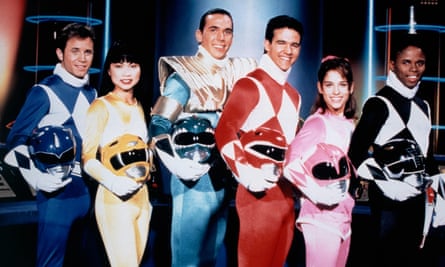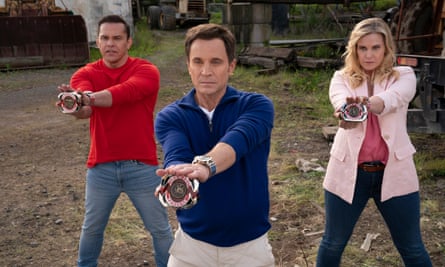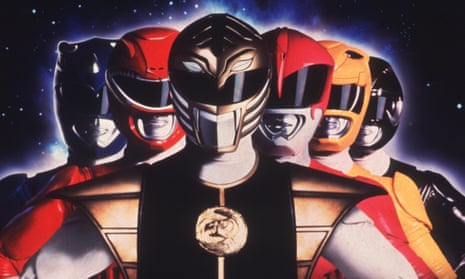In the mid 1980s, the Israeli-American media mogul Haim Saban was stuck in a Tokyo hotel with nothing to watch on TV. Until, that is, he came across five spandex-wearing masked superheroes battling outlandish rubber monsters – and decided to adapt Japanese show, Super Sentai, for US TV, as Mighty Morphin Power Rangers.
When its pilot made it to air in 1993, viewers were treated to an evil space witch escaping moon imprisonment to battle an android-assisted character who was simultaneously a wizard and a big head in a jar. There were giant mech robots known as Zords, plus the martial arts and acrobatic skills of their operators – “five teenagers with attitude”. Their grandiose hope? To save the Earth from the forces of evil – and hopefully keep the actors playing them away from the breadline.
“I lived in an apartment with no furniture, I slept on the floor and used boxes to put my TV on,” says actor David Yost of his early days in Los Angeles before being cast as the Blue Power Ranger. Luckily, his time having almost nothing to his name only lasted three months. Once he started making a living from battling the space witch – AKA arch-villain Rita Repulsa – success was instant, if baffling. “We filmed 40 episodes, then once it aired, it became this thing we couldn’t explain,” he smiles.

The stratospheric success of Mighty Morphin Power Rangers outstripped anything that had been expected of it. The energising mash-up of Japanese action footage – where sparks shot out of the costumes anytime a ranger was struck – and campy, cheesy one-liners from the US-created script proved to be a hit with kids. Ratings were through the roof and toy sales quickly exceeded expectations. Fox ordered 20 more episodes, sending the production company, Saban Entertainment, scrambling for footage.
The more episodes they created, the more ludicrous the onscreen antics ended up becoming. Jason Narvy, who played the slapstick comic relief character Skull, remembers “being dressed as an old woman for one scene, then an hour later running down the street with a small chimpanzee”. The absurdity of the show was not lost on him. He recalls one time both acting and serving as assistant director. “I’m in 18th-century British military regalia,” he says, “there’s a stunt guy dressed as a rat and ready to be hurled across a wire rig by an air cannon. I wave my sword to yell: ‘Action!’ That’s, like, Monty Python stuff.”
Preposterous storylines and bizarre villains were all part of the appeal. Limited by the Japanese Sentai footage, Saban leaned into the wacky elements. “We had a lipstick monster; we fought a pachinko machine; we fought a turtle that had a stop light on its head,” says Yost. “The list goes on and on.” David Fielding, who played omnipotent recruiter Zordon, was tickled by the show’s villains, as he would often “walk into the recording booth and ask: ‘What monster are we fighting this week? The giant purse. Fantastic!’”
Narvy says that “on any given day, some five-headed monster with 8,000 eyeballs would casually walk past you on the way to the set. Once we had a delivery guy dropping something off at the front desk. When one of these monstrosities walked past, he just stared at me, incredulous. I said, “Well, there’s something you don’t see everyday … Of course, I do.”
However, in the years since it first broadcast, the show has faced criticism for its sometimes blatant racial stereotyping of the cast, such as the only Black actor being the breakdancing Black Ranger and the Asian cast member playing the Yellow Ranger. Yost, though, suggests that the show’s inclusion of different ethnic backgrounds on screen, fighting evil together, preceded a lot of racial representation that we see in kids’ TV today – particularly in terms of the depiction of Trini, the Yellow Ranger character, played by Thuy Trang. “It was a groundbreaking role,” he says. “And for Asian women especially, because they’re being represented and she was strong, powerful and a superhero.”

Production was also famously problematic. Cast disputes about low pay reportedly affected filming, and eventually led to three of the cast quitting. (Walter Emanuel Jones, who played the Black Ranger, claimed: “I could have worked the window at McDonald’s and probably made the same money the first season.”) Safety issues stemming from it being a non-unionised production were also an issue according to Amy Jo Johnson, who played the original Pink Ranger. In a 2017 open letter in Variety she wrote that she “almost died a few times because of the makeshift low-budget stunts we performed”.
Most notoriously, Yost has alleged that homophobia and harassment were behind his departure in 1996, having told NBC that it caused him to become suicidal. Although homophobia is not a topic he addresses during our interview, Yost does say that “as young actors, we were just signing contracts because you’re going to make more money than being a waiter.” The cast felt they were dispensable in the eyes of the production. “The person in charge was not a gracious person,” he says. “He was like: ‘If you don’t like it, you’ll be replaced. The kids don’t like you, they like the colours.’” Saban Entertainment would sell the franchise to Hasbro in 2018 for $522m (£419m).
Power Rangers, though, has never really gone away, rotating its cast of superheroes every few years and becoming one of the world’s longest-running live-action kids’ TV shows. But now it’s attempting to pay homage to its roots with a worldwide, feature-length Netflix special. Mighty Morphin Power Rangers: Once & Always celebrates the 30-year anniversary of the brand, in a show that sees the return of Rita Repulsa alongside two of the original rangers: Yost, as the Blue Ranger Billy, and Walter Emanuel Jones, as the Black Ranger Zack. The Pink, Red and Yellow Rangers are from the second generation of cast members – who replaced the originals when they left – as not every previous actor was overjoyed at the idea of appearing.

“Please stop saying I didn’t do [the] reunion because of money,” wrote Johnson on Twitter. “Simply not true. Maybe I just didn’t want to wear spandex in my 50s or couldn’t go to NZ for a month. Or none of ur beeswax,” she added. According to her, co-star Jason David Frank, who played the Green Ranger, Tommy, had also decided not to take part, prior to killing himself last November. “JDF & I both chose not to for our own reasons. They filmed before he passed.”
after newsletter promotion
Trang died in a car accident in 2001, and Yost says the special is a tribute to the two original cast members lost since filming ceased. It is dedicated to Trang and Frank, with a particular attempt to honour Trang by introducing Charlie Kersh as Minh, the onscreen daughter of Trang’s Yellow Ranger character, Trini. Trini’s previous colleagues, Billy and Zack, take Minh under their wing and train her to become part of their troupe, in a plot that sees the heroes reunite to avenge the death of the Yellow Ranger. It also features a number of returning voice actors, locations and characters – including the musician behind the much-loved Go Go Power Rangers theme tune. It’s all very much in keeping with the tone of the original.
“The word cheesy gets thrown around as though it’s a bad thing,” says Alwyn Dale who, along with Becca Barnes, is the head writer on the project. “But there’s a real joy to the tone of Power Rangers that has to be protected. The minute it becomes too serious or grimdark, there’s a real gut feeling that rejects that.”
The project was kickstarted by Yost, who pitched it as an eight-part miniseries to Netflix a few years ago. In January 2023, he shared the script for the first two episodes on Twitter in the hope that “they would jump on [them] and develop [them] for the 30-year anniversary”. Citing legal issues, Netflix declined, instead offering Yost what became Power Rangers: Once & Always. “I don’t want to use the word ‘consolation’,” he says, “but they said: ‘We can’t do that right now – we can create this special.’ It was a lot of work on their part to get from there to a shooting script. I gave my input and I think it turned out pretty good.”
Given how much personal turmoil the franchise has previously caused Yost, you can’t help but wonder: why would he want to revisit it? Apparently, new owners Hasbro being happy to take the actors’ wellbeing seriously played a big part.
“When we originally filmed, we didn’t have a lot of protections, we didn’t have health insurance,” says Yost. “I, being a young dumb Hollywood kid, got into a bar fight and got my nose broken in season one, so I’m walking around with a broken nose. I think at that point [Saban] realised ‘we should maybe give these kids a stipend, a certain amount of money that they can apply to getting health insurance’. That instance woke them up, but unfortunately never woke them up to deal with the union.” He finishes by saying, “I’m so grateful to Hasbro for listening to me, and taking it seriously to do this under the contracts and rules of the Screen Actors Guild Union – that’s the big difference.”
Throughout its three-decade history, the Power Rangers franchise has entertained generation after generation of children, as well as generating billions in merchandise revenue. What makes it stand the test of time? Fielding thinks that many viewers were inspired by it to pursue specific careers, “like emergency medical technicians or firefighters, serving the general public”. Yost, meanwhile, holds that the show’s success is a testament “to the chemistry the original cast had together”. Narvy argues it is in its appeal to so many different kids: “At a time when superheroes were largely one type, one gender, one ethnicity, Power Rangers celebrated and empowered diversity. Kids saw themselves represented on screen.” Whatever its secret, with the new Netflix special it doesn’t look like ending any time soon.
This article was amended on 14 April 2023. In an earlier version, an image showing the show’s original cast misnamed the actor playing the Red Ranger as Steve Cardenas, rather than Austin St John.
Mighty Morphin Power Rangers: Once & Always is on Netflix from 19 April.
